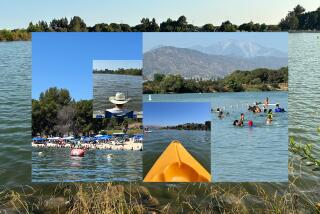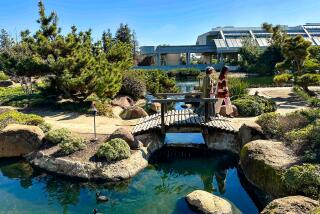Wander Lonely as a Cloud in England’s Beautiful Lake District
- Share via
“What’s the best walk to Wordsworth’s cottage?” I asked at the Information Center in Ambleside, England.
“Take the old coffin route through woodland and across meadows to Grasmere and Dove Cottage,” responded the gentleman behind the counter, referring to the poet’s former home. “Do return by the shores of Grasmere and Rydal lakes. It’s a good way to get introduced to the lakes in the Lake District.”
For the record:
12:00 a.m. Sept. 8, 2002 For The Record
Los Angeles Times Tuesday September 03, 2002 Home Edition Main News Part A Page 2 National Desk 0 inches; 27 words Type of Material: Correction
Lake District mountain--The Travel section’s hiking column Sunday incorrectly said Scafell is England’s highest mountain. Scafell Pike is the highest.
For The Record
Los Angeles Times Sunday September 08, 2002 Home Edition Travel Part L Page 6 Features Desk 3 inches; 113 words Type of Material: Correction
England’s highest peak--The hiking column Sept. 1 (“Wander Lonely as a Cloud in England’s Beautiful Lake District”) incorrectly said Scafell is England’s highest mountain. Scafell Pike is the highest.
The district is a hiker’s nirvana: lovely lakes surrounded by England’s most rugged mountains, all within the country’s largest national park. Information-center staff and locals are knowledgeable about the superb network of pathways and cheerfully suggest walks suited to visitors’ interests and abilities as well as the ever-changing weather. Inexpensive maps and guidebooks to Lake District National Park also help.
William Wordsworth first floated the notion of preserving the Lake District as “national property” in the 1835 edition of his “Guide to the Lakes.” That vision became reality in 1951, when England established the national park.
We remember Wordsworth for his romantic poetry, but his “Guide to the Lakes” was hugely popular in his day. The guide earned so much attention that Wordsworth often was asked whether he had written anything else.
Wordsworth may have put the Lake District on the map, but it took the addition of steamboats on the lakes to entice visitors and expanded train service to get them there.
The railway is still a great way to go. A four-hour train ride takes travelers from London to Oxenholme, just outside the Lake District, then another branch makes the half-hour trip to the town of Windermere. I flew from Los Angeles to London, then rode a train north, arriving for an early evening walk in the Lake District less than 20 hours after I left LAX.
Ice Age glaciers formed the lakes, known in this part of England as “waters” or “meres.”
Windermere, England’s largest lake, can be enjoyed by steamboat ride or shoreline saunter.
Some say curvy Ullswater is the district’s most beautiful lake; it inspired some of Wordsworth’s most famous passages. The young poet “wandered lonely as a cloud” and celebrated the daffodils blossoming on the pastoral slopes above.
Others think that Derwent Water lives up to the nickname “Queen of the Lakes,” its beauty accented by a mountain backdrop. Hikers can make an 11-mile circuit around romantic Derwent Water; the less intrepid can board one of the boats that circle the lake, shuttling from dock to dock.
Shorter hiking routes can be found at Buttermere (four miles), Rydal Water (three miles) and Grasmere (four miles).
One of the best tactics is to base yourself in a centrally located, walker-friendly town such as Grasmere, Windermere or Keswick. Step out of your lodging and take what British hikers call a “circular walk,” or plan a one-way adventure with the help of a bus or taxi. I stayed in Ambleside, which has fabulous footpaths, restaurants, pubs and stores with quality hiking apparel and accessories.
Lakes aren’t the only attraction of the Lake District. Jagged peaks of volcanic rock thrust skyward from lush, deep valleys. More than 100 summits, called “fells,” exceed 2,000 feet. The views stretch across mountain tarns (little lakes among the crags), dense woods, tumbling streams, drowsy hamlets and the Irish Sea.
These mountains are among the world’s oldest--more ancient than the Himalayas and the Alps. The youngest rock formations are more than 200 million years old.
It’s hard to resist the call of peaks named Cat Bells, Hay Stacks or the Old Man of Coniston. One of the most popular peaks is Helvellyn, the so-called Sunrise Mountain because so many ramblers make the ascent in the morning.
Scafell, at 3,162 feet the highest point in England, is irresistible. The peak is so popular that on some busy days, climbers queue up to stand on the summit.
Millions of rocks have been put to good use in the form of dry-stone walls--ones built without cement or mortar. These centuries-old walls separate pastures and property lines and pattern the hills in a lovely way, sometimes extending in ruler-straight lines for miles. Walkers are constantly opening and closing gates and stepping over stiles.
Wordsworth, Samuel Taylor Coleridge and their contemporaries are often credited with popularizing the sport of walking. After visiting their homes and haunts here, one can easily understand why they walked 15, 20 or 25 miles a day--and how they were inspired to write such great poetry.
For those of you who make the trip, a few tips: Expect crowds around the major lakes during the summer, particularly on weekends. Though paths were closed last year to prevent the spread of foot-and-mouth disease, the livestock epidemic was declared over in January; travel restrictions were lifted, and walkers are returning. Fall and spring are excellent times to visit.
Weather changes rapidly. A bright and sunny start does not guarantee a warm and dry experience atop mountains, so dress accordingly.
Good places to research a trip are www.cumbria-the-lake-district.co.uk and www.lake-district.gov.uk.
Tour companies with Lake District itineraries include English Lakeland Ramblers, (800) 724-8801, www.ramblers.com; the Wayfarers, (800) 249-4620, www.thewayfarers.com; and Discerning Traveller, with offices in Oxford, England, 011-44-186-551-2732, www.discerning-traveller.co.uk.
For more of John McKinney’s tips, visit his Web site, www.thetrailmaster.com.
More to Read
Sign up for The Wild
We’ll help you find the best places to hike, bike and run, as well as the perfect silent spots for meditation and yoga.
You may occasionally receive promotional content from the Los Angeles Times.






